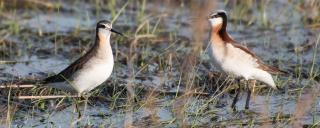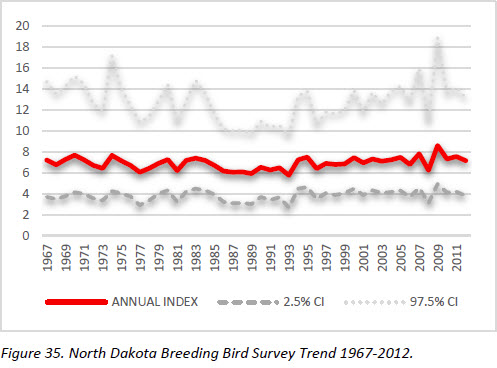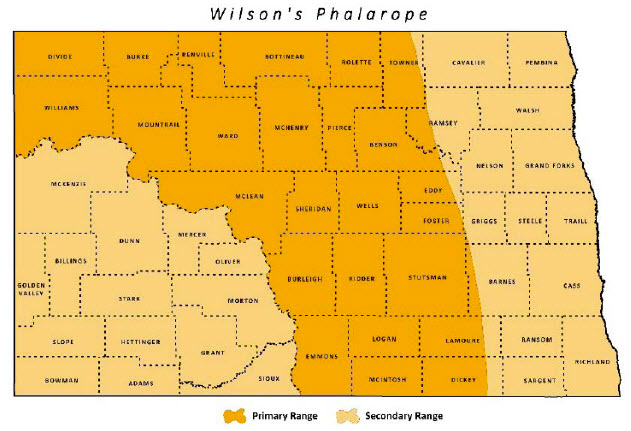
Wilson's Phalarope
| Scientific Name | Phalaropus tricolor |
|---|---|
| General Description | L 9.25”, WS 17”, 2.1 oz. Females sport a brown-red and gray back, cinnamon neck, white throat and belly. Males are light gray and white. |
| Status | Occurs in North Dakota from mid-April to September. Peak breeding season occurs from late May to early July. |
| Abundance | Common to abundant. |
| Primary Habitat | Shallow wetlands and mudflats, nest in the margins of wetlands. |
| Federal Status | Migratory Bird. |
| Reason for Designation | An estimated 1/3 of this species’ population breeds in the Prairie Pothole Region. There is uncertainty regarding if the population is indeed declining, some evidence indicates a more stable trend over the short-term, therefore it has been removed from the USFWS Birds of Conservation Concern. Least Concern in Shorebirds of Conservation Concern 2015. |
Locations and Conditions of Key Habitat
Preferred Habitat
Wetlands with open water, emergent vegetation, and open shoreline are used for foraging, and wet meadows or upland grasslands are used for nesting. Typically nest less than 100m from the shoreline, in the uplands early in the breeding season and in wetmeadow vegetation later in the season. Nests are located in grasses of various heights in idle, hayed, or grazed grasslands adjacent to wetlands. Also nest on islands. Tilled wetlands, temporary, seasonal, semi-permanent, fen, alkali, and permanent wetlands, in decreasing order, are utilized most frequently. Occur in the peripheral low-prairie and wet meadow areas of wetlands. Primary food items include a variety of aquatic invertebrates.
Key Areas and Conditions for Wilson's Phalarope in North Dakota
No specific sites have been identified. Fairly common throughout Missouri Coteau and Drift Plains, particularly the southern portions.
Problems Which May Affect this Species
Habitat
Conversion of grassland to cropland, energy development and urban expansion. Degradation of grasslands from invasive plants, woody encroachment, succession, and loss of diversity. Loss or degradation of wetlands.
Other Natural or Manmade Factors
Nest mortality may be higher than species utilizing similar habitat, possibly because of the phalarope’s tendency to place nests in the margins of wetlands where they are more easily flooded. Exposure to agrochemicals is also a concern. Mortality from collisions with power lines. Expanding oil and gas development in North Dakota increases risk of oilfield contamination of wetland habitat.
Research and Survey Efforts
Current Research or Surveys
- Since 2004, the USFWS HAPET staff has coordinated a breeding shorebird survey in the Prairie Pothole Region of North and South Dakota. Surveys are conducted twice to correspond with the shorebird breeding season. Five grassland breeding shorebird species are targeted, including Wilson’s Phalarope. Results from these surveys help guide grassland and conservation efforts.
Previous Research or Surveys
- Ducks Unlimited (ND SWG T2-2-R) determined wetland occupancy by shorebirds in wind energy developments in the Prairie Pothole Region of North Dakota. The project was initiated in 2009 and a final report provided in 2011. Results indicate wind energy was probably not causing substantial reductions in shorebird occupancy, including Wilson’s Phalarope. However, apparent presence of shorebirds was low and potential effects of wind development on shorebird populations needs further research and monitoring (Walker and Gleason 2011, Niemuth et al. 2013).
- Delta Waterfowl (ND SWG T-13-R) determined shorebird nest success and nest-site selection in northeast North Dakota. The project was initiated in 2005 and a final report provided in 2007. Vegetation surrounding shorebird nests was relatively short, sparse, native grass species. Shorebirds avoided sites dominated by invasive plants (e.g. leafy spurge, Canada thistle, Kentucky bluegrass, smooth brome, stinging nettle, and wormwood.) Habitat has a stronger impact on shorebird nest success than predator removal (Wiens 2007).
- Ducks Unlimited (ND SWG T-3-1 and T-8-R) determined demographic performance of prairie-nesting shorebirds in North Dakota. The project was initiated in 2004 and a final report provided in 2007. The highest reproductive success for shorebirds was in those areas with high amounts of grassland, low levels of edge between cropland and grassland, and high amount of wetland area. Preserving large intact grassland/wetland landscapes are key to safeguarding populations of Wilson’s Phalarope (Stephens and Walker 2007).
- Numerous published reports and gray literature on this species throughout its range and in North Dakota.
Additional Research or Surveys Needed
Identify key staging areas.
Population and Trend Estimates

- North American Population Estimate 2012: 150,000
- North Dakota BBS Trend: see figure 35
- Survey-wide BBS Trend 1966-2012: -0.64
Management Recommendations
- Preserve grasslands, wetlands, and wetland complexes.
- Protect wet-meadow areas from cultivation.
- Do not mow, burn, or heavily graze nesting habitat during breeding season.
- Utility development should follow the guidance of “Reducing Avian Collisions with Power Lines” including marking power lines and creating an Avian Protection Plan.
Monitoring Plans
The Breeding Bird Survey continues to be a useful monitoring tool, however the annual surveys implemented by HAPET in 2004 are valuable. Ensuring all BBS routes are conducted annually is priority. A shorebird monitoring plan should follow The International Shorebird Survey (ISS) Program for Regional and International Shorebird Monitoring (PRISM) and “Guidance for Developing and Implementing Effective Shorebird Surveys.”
2005-2015 Progress
The Wilson’s Phalarope remains a Level I Species of Conservation Priority. Several State Wildlife Grant Projects (T2-9-R, T2-11-HM, T-18-R, T-21-D, T-22-HM, T-23-HM, T-25-HM, T-27-HM, T-37-D) have contributed to habitat enhancement of wetlands and grasslands for Wilson’s Phalarope and other wetland/grassland dependent birds.

Note: A listing of works consulted when compiling the information on this page may be found in the 2015 State Wildlife Action Plan.
